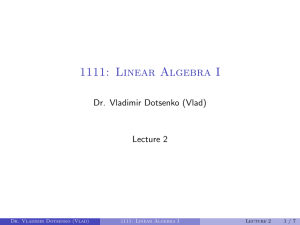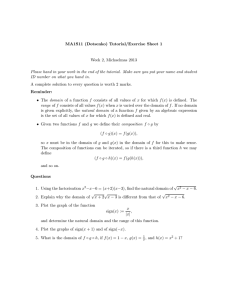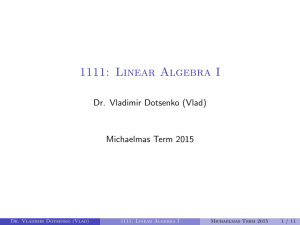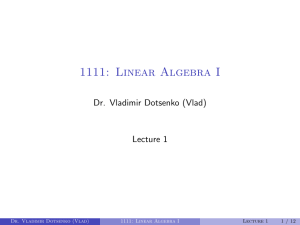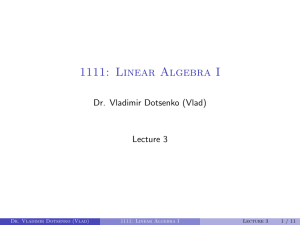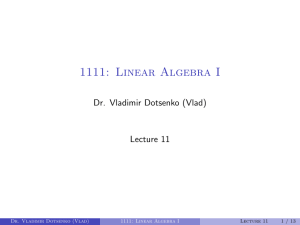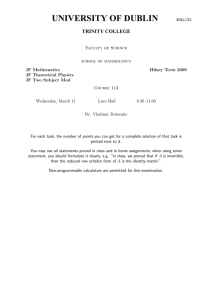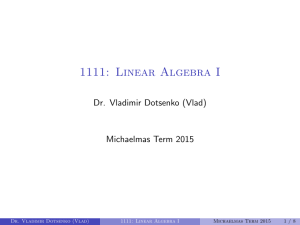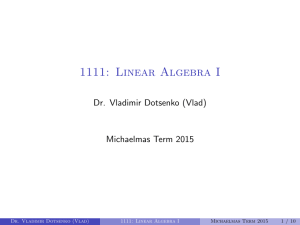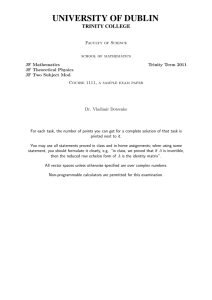1111: Linear Algebra I Dr. Vladimir Dotsenko (Vlad) Michaelmas Term 2015
advertisement
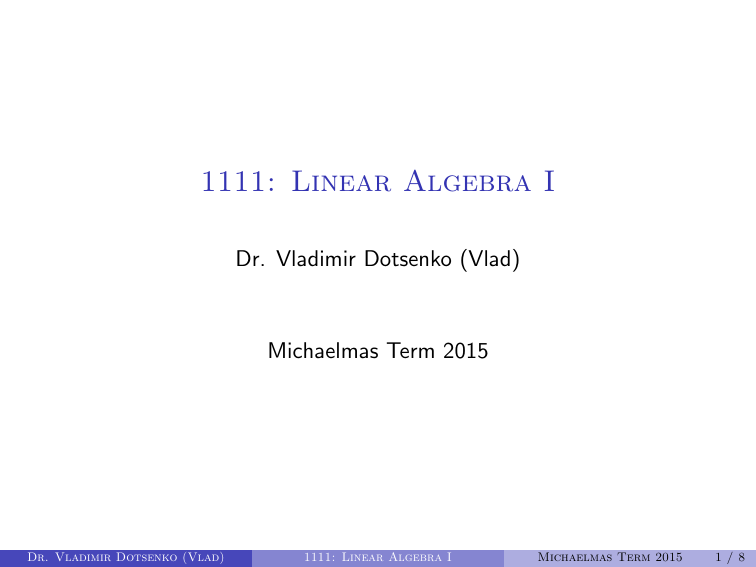
1111: Linear Algebra I Dr. Vladimir Dotsenko (Vlad) Michaelmas Term 2015 Dr. Vladimir Dotsenko (Vlad) 1111: Linear Algebra I Michaelmas Term 2015 1/8 Matrix product One definition is immediately built upon what we just defined before. Let A be an m × n-matrix, and B an n × k-matrix. Their product A · B, or AB, is defined as follows: it is the m × k-matrix C whose columns are obtained by computing the products of A with columns of B: A · (b1 | b2 | . . . | bk ) = (A · b1 | A · b2 | . . . | A · bk ) Another definition states that the product of an m × n-matrix A and an n × k-matrix B is the m × k-matrix C with entries Cij = Ai1 B1j + Ai2 B2j + · · · + Ain Bnj (here i runs from 1 to m, and j runs from 1 to k). In other words, Cij is the “dot product” of the i-th row of A and the j-th column of B. Dr. Vladimir Dotsenko (Vlad) 1111: Linear Algebra I Michaelmas Term 2015 2/8 Examples 0 1 0 0 2 3 1 Let us take U = ,V = ,W = . 0 0 1 0 5 2 0 Note that the products U · U, U · V , V · U, V · V , U · W , and V · W are defined, while the products W · U, W · V , and W · W are not defined. 0 0 1 0 0 0 We have U · U = , U ·V = , V ·U = , 0 0 0 0 0 1 0 0 5 2 0 0 0 0 V ·V = , U ·W = , V ·W = . 0 0 0 0 0 2 3 1 In particular, even though both matrices U · V and V · U are defined, they are not equal. Dr. Vladimir Dotsenko (Vlad) 1111: Linear Algebra I Michaelmas Term 2015 3/8 Matrix product: third definition However, these two definitions appear a bit ad hoc, without no good reason to them. The third definition, maybe a bit more indirect, in fact sheds light on why the matrix product is defined in exactly this way. Let us view, for a given m × n-matrix A, the product A · x as a rule that takes a vector x with n coordinates, and computes out of it another vector with m coordinates, which is denoted by A · x. Then, given two matrices, an m × n-matrix A and an n × k-matrix B, from a given vector x with k coordinates, we can first use the matrix B to compute the vector B · x with n coordinates, and then use the matrix A to compute the vector A · (B · x) with m coordinates. By definition, the product of the matrices A and B is the matrix C satisfying C · x = A · (B · x) . Dr. Vladimir Dotsenko (Vlad) 1111: Linear Algebra I Michaelmas Term 2015 4/8 Equivalence of the definitions The first and the second definition are obviously equivalent: the entry in the i-th row and the j-th column of the matrix (A · b1 | A · b2 | . . . | A · bk ) B1j B2j is manifestly equal to Ai1 B1j + Ai2 B2j + · · · + Ain Bnj . (Note that . .. Bnj is precisely bj , the j-th column of B). Dr. Vladimir Dotsenko (Vlad) 1111: Linear Algebra I Michaelmas Term 2015 5/8 Equivalence of the definitions For the third definition, note that the property C · x = A · (B · x) must hold for all x, in particular for x = ej , the standard unit vector which has the j-th coordinate equal to 1, and all other coordinates equal to zero. Note that for each matrix M the vector M · ej (if defined) is equal to the j-th column of M. In particular, A · (B · ej ) = A · bj . Therefore, we must use as C the matrix A · B from the first definition (whose columns are the vectors A · bj ): only in this case C · ej = A · bj = A · (B · ej ) for all j. To show that C · x = A · (B · x) for all vectors x, we note that such a vector can be represented as x1 e1 + · · · + xk ek , and then we can use properties of products of matrices and vectors: A · (B · x) = A · (B · (x1 e1 + · · · + xk ek )) = = A · (x1 (B · e1 ) + · · · + xk (B · ek )) = x1 A · (B · e1 ) + · · · + xk A · (B · ek ) = = x1 C · e1 + · · · + xk C · ek = C · (x1 e1 + · · · + xk ek ) = C · x. Dr. Vladimir Dotsenko (Vlad) 1111: Linear Algebra I Michaelmas Term 2015 6/8 Properties of the matrix product Let us show that the matrix product we defined satisfies the following properties (whenever all matrix operations below make sense): A · (B + C ) = A · B + A · C , (A + B) · C = A · C + B · C , (c · A) · B = c · (A · B) = A · (c · B), (A · B) · C = A · (B · C ) All these proofs can proceed in the same way: pick a “test vector” x, multiply both the right and the left by it, and test that they agree. (Since we can take x = ej to single out individual columns, this is sufficient to prove equality). For example, the first equality follows from (A · (B + C )) · x = A · ((B + C ) · x) = A · (B · x + C · x) = A · (B · x) + A · (C · x) = (A · B) · x + (A · C ) · x = (A · B + A · C ) · x Dr. Vladimir Dotsenko (Vlad) 1111: Linear Algebra I Michaelmas Term 2015 7/8 The identity matrix Let us also define, for each n, the identity matrix In , which is an n × n-matrix whose diagonal elements are equal to 1, and all other elements are equal to zero. For each m × n-matrix A, we have Im · A = A · In = A. This is true because for each vector x of height p, we have Ip · x = x. (The matrix Ip does not change vectors; that is why it is called the identity matrix). Therefore, (Im · A) · x = Im · (A · x) = A · x, (A · In ) · x = A · (In · x) = A · x . Dr. Vladimir Dotsenko (Vlad) 1111: Linear Algebra I Michaelmas Term 2015 8/8
